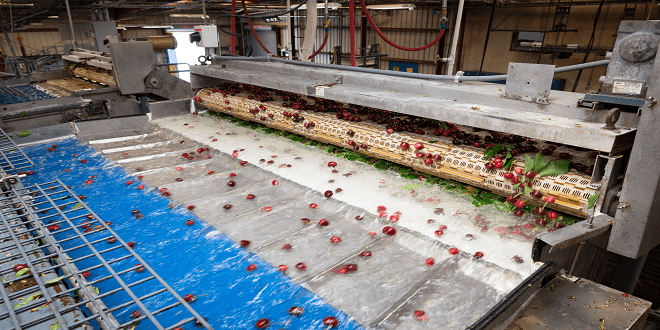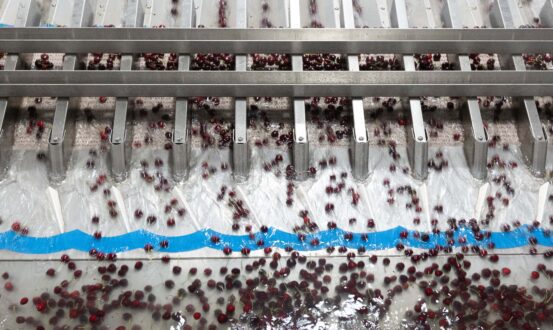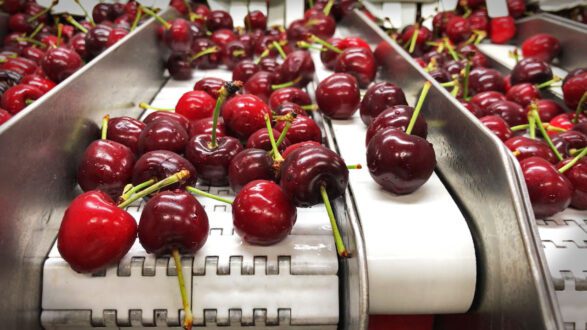

May 8, 2023Technology revolutionizes cherry, small fruit grading, packing
Technology upgrades have swept through West Coast fruit packinghouses, with everything from stone fruit, apples and citrus processed on more sophisticated equipment than a generation ago.
That includes cherries, which present several special handling needs: they’re small and must be handled gently because they’re fragile and damage easily. Cherry lines with optic sizing and sorting technology can be found in cherry packing facilities in California and the Pacific Northwest. These include machines from Unitec, TOMRA and MAF Industries.


“The advent of electronic defect sizing and sorting, or what we call ‘optic’ sizing and sorting has greatly increased consistency in fruit size and grading over the past ’10-ish’ years,” said Brianna Shales, director of marketing for Stemilt Growers, which grows and packs Bings, Rainiers and specialty variety Skyler Rae cherries. “Prior to this technology, we had sizing capabilities but they weren’t as precise.”
Packing line workers used to be tasked with sorting the fruit, she said.
“Sorting was done by people, and success could vary because it was done by the human eye,” Shales said. “We’ve benefited greatly from this technology because we are able to pack cherries into key sizes, color lines, grades, etc. and do so efficiently.”
Norway-based TOMRA has a location in Salinas, California, that serves 11 cherry packing clients in California, Oregon and Washington. Its U.S. operations pack about 40% of U.S. cherries each season, said Benedetta Ricci Iamino, global category director for cherries at TOMRA Food.
Inspection cameras
The TotalView inspection cameras on TOMRA cherry lines are at lower angles and closer to the fruit, Ricci Iamino said, providing high-quality images to detect tip breaks, mold at the stem growth and cuttings.
“This technology also increases output, improves product quality, reduces the problems associated with recruiting and retaining labor, reduces food waste and maximizes pack out,” she said.


Overall, TOMRA cherry equipment’s packing, sizing and grading technology leads to increased packouts of premium packs, reduced giveaways and greater homogeneity of fruit size, Ricci Iamino said. Customers can program their own preferred tolerances for different product grades, which can lower food waste and maximize the value of each piece of fruit.
“Defect classification also makes it possible to see packout by grade, to see which defects are resulting in the grades, and to provide feedback to suppliers to help improve future orchard management,” Ricci Iamino said.
Consistency and quality
Shales said retailers and consumers benefit from the consistency and quality of cherries packed on the high-tech cherry lines.
“We are able to pack to specifications, and have better controls over grading fruit, which is especially beneficial when crop abnormalities come into play (such as rain cracks on cherries),” she said. “Ultimately, we seek to produce cherries that meet our high ‘World Famous’ standards and do this consistently.”


A current challenge for cherry packers is the rapid change in packaging requirements for different export markets, Ricci Iamino said.
“For instance, during the past cherry season in the Southern Hemisphere, there was a booming demand in the Chinese market for small-medium size packages, especially 2.5 kilograms,” she said. “This is largely due to the demographic of the consumers (young single people and small-size families) that prefer to buy smaller packages as the price of small packs is relatively cheaper.”
The next stage of development for TOMRA sorting equipment is improving the scanning of the surface of cherries to further optimize packout, Ricci Iamino said.
— Chris Koger, managing editor
Top photo: Stemilt Growers, Wenatchee, Washington, has better control in grading and sorting fruit with high-tech equipment in its Stockton, California, facility Photo: Stemilt














